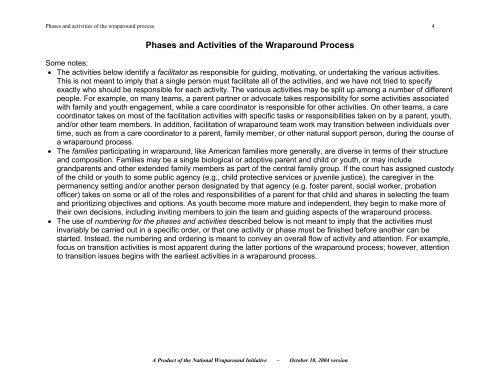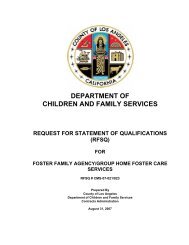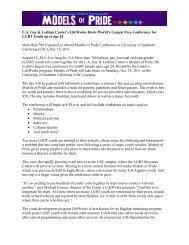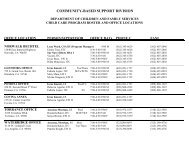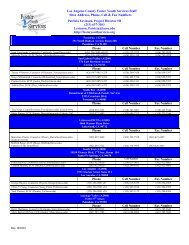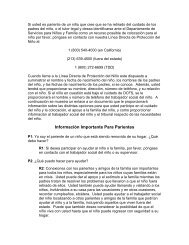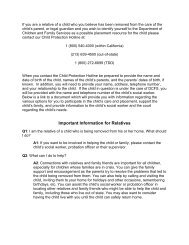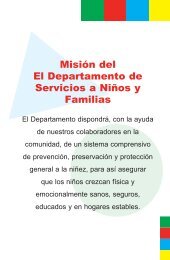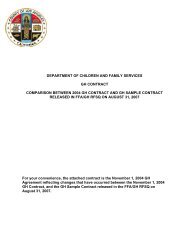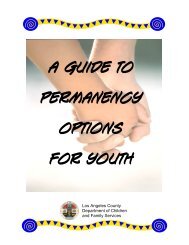Phases and Activities of the Wraparound Process - Los Angeles ...
Phases and Activities of the Wraparound Process - Los Angeles ...
Phases and Activities of the Wraparound Process - Los Angeles ...
Create successful ePaper yourself
Turn your PDF publications into a flip-book with our unique Google optimized e-Paper software.
<strong>Phases</strong> <strong>and</strong> activities <strong>of</strong> <strong>the</strong> wraparound process 4<br />
<strong>Phases</strong> <strong>and</strong> <strong>Activities</strong> <strong>of</strong> <strong>the</strong> <strong>Wraparound</strong> <strong>Process</strong><br />
Some notes:<br />
• The activities below identify a facilitator as responsible for guiding, motivating, or undertaking <strong>the</strong> various activities.<br />
This is not meant to imply that a single person must facilitate all <strong>of</strong> <strong>the</strong> activities, <strong>and</strong> we have not tried to specify<br />
exactly who should be responsible for each activity. The various activities may be split up among a number <strong>of</strong> different<br />
people. For example, on many teams, a parent partner or advocate takes responsibility for some activities associated<br />
with family <strong>and</strong> youth engagement, while a care coordinator is responsible for o<strong>the</strong>r activities. On o<strong>the</strong>r teams, a care<br />
coordinator takes on most <strong>of</strong> <strong>the</strong> facilitation activities with specific tasks or responsibilities taken on by a parent, youth,<br />
<strong>and</strong>/or o<strong>the</strong>r team members. In addition, facilitation <strong>of</strong> wraparound team work may transition between individuals over<br />
time, such as from a care coordinator to a parent, family member, or o<strong>the</strong>r natural support person, during <strong>the</strong> course <strong>of</strong><br />
a wraparound process.<br />
• The families participating in wraparound, like American families more generally, are diverse in terms <strong>of</strong> <strong>the</strong>ir structure<br />
<strong>and</strong> composition. Families may be a single biological or adoptive parent <strong>and</strong> child or youth, or may include<br />
gr<strong>and</strong>parents <strong>and</strong> o<strong>the</strong>r extended family members as part <strong>of</strong> <strong>the</strong> central family group. If <strong>the</strong> court has assigned custody<br />
<strong>of</strong> <strong>the</strong> child or youth to some public agency (e.g., child protective services or juvenile justice), <strong>the</strong> caregiver in <strong>the</strong><br />
permanency setting <strong>and</strong>/or ano<strong>the</strong>r person designated by that agency (e.g. foster parent, social worker, probation<br />
<strong>of</strong>ficer) takes on some or all <strong>of</strong> <strong>the</strong> roles <strong>and</strong> responsibilities <strong>of</strong> a parent for that child <strong>and</strong> shares in selecting <strong>the</strong> team<br />
<strong>and</strong> prioritizing objectives <strong>and</strong> options. As youth become more mature <strong>and</strong> independent, <strong>the</strong>y begin to make more <strong>of</strong><br />
<strong>the</strong>ir own decisions, including inviting members to join <strong>the</strong> team <strong>and</strong> guiding aspects <strong>of</strong> <strong>the</strong> wraparound process.<br />
• The use <strong>of</strong> numbering for <strong>the</strong> phases <strong>and</strong> activities described below is not meant to imply that <strong>the</strong> activities must<br />
invariably be carried out in a specific order, or that one activity or phase must be finished before ano<strong>the</strong>r can be<br />
started. Instead, <strong>the</strong> numbering <strong>and</strong> ordering is meant to convey an overall flow <strong>of</strong> activity <strong>and</strong> attention. For example,<br />
focus on transition activities is most apparent during <strong>the</strong> latter portions <strong>of</strong> <strong>the</strong> wraparound process; however, attention<br />
to transition issues begins with <strong>the</strong> earliest activities in a wraparound process.<br />
A Product <strong>of</strong> <strong>the</strong> National <strong>Wraparound</strong> Initiative – October 10, 2004 version


